Hiking To the Roof of New York: Adventure in the Adirondacks
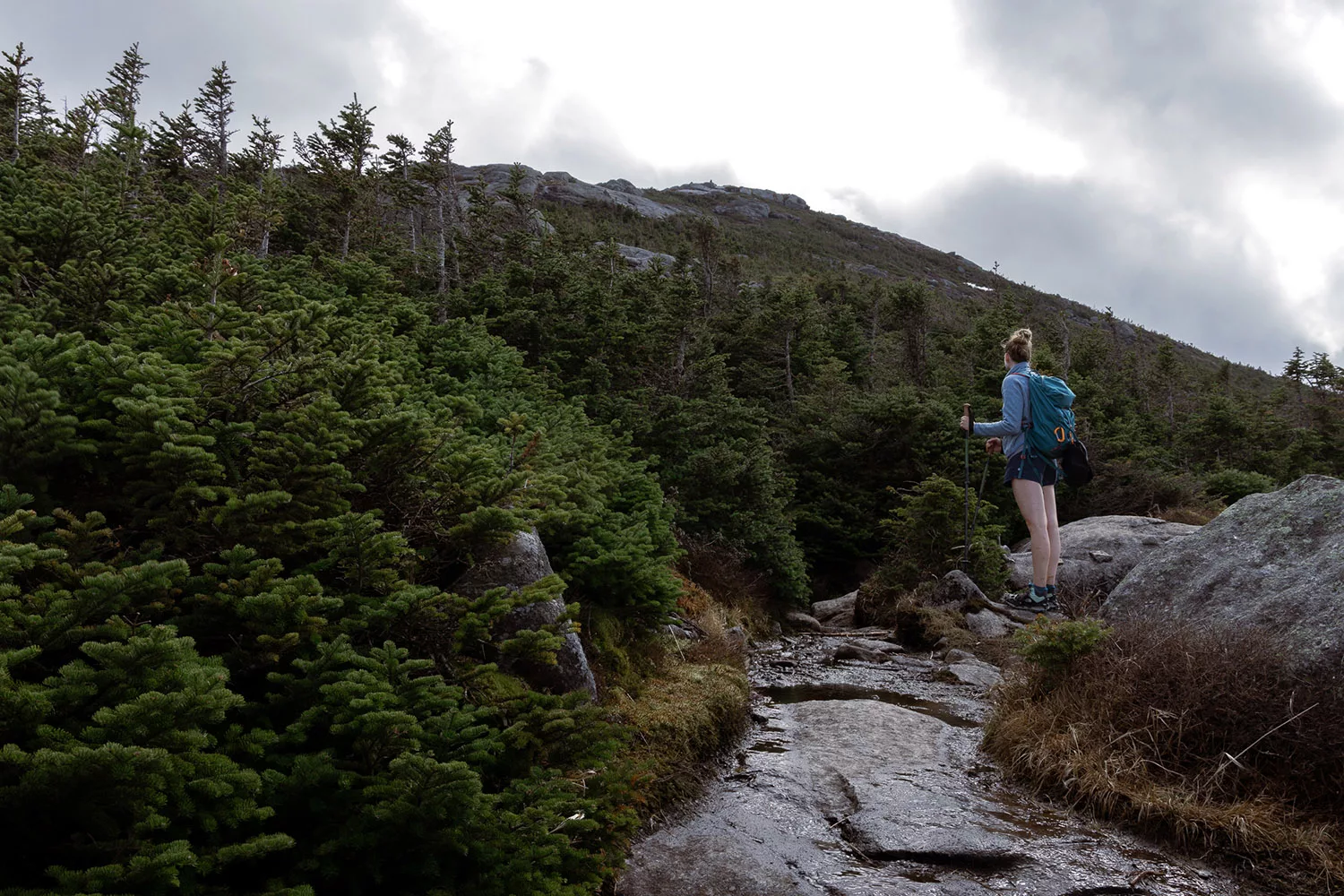
At 1,629 metres above sea level, Mount Marcy (Tewawe’éstha) erupts over the treeline to proudly assert itself as the pinnacle of the Adirondack Mountain landscape. Beneath its rounded peak lies over 3,000 kilometres of rugged hiking trails, 3,000 lakes and almost 50,000 kilometres of rivers and streams that make up the Adirondack Park, the largest protected natural area in the contiguous United States. Forty-five other High Peaks (mountains above 1,219 metres) add to the vast wilderness area, making it a hiker’s paradise in the northeast.
Situated in New York State just south of both the Ontario and Quebec border, the park is approximately 3.5 times the size of Algonquin Park, comprising of wilderness areas, private land and towns nestled between the trees. Within an approximate two-hour drive of several Canadian towns and cities, the Adirondacks are a hot spot for Canadian tourism.
 Mitch Bowmile
Mitch Bowmile
Every year, Canadian tourists share a sizable contribution to the 7-12 million people who visit the park. Rising above it all is the aforementioned Mount Marcy, the closest mountain above 1,600 metres to every Canadian living between Sault St. Marie, Ontario and Montreal, Quebec, making it a worthy trek for Canadians seeking an alpine adventure.
On weekends long and short, the influx of Canadians is dominant in the ‘Dacks. Subjectively speaking from experience, you’re just as likely to hear people conversing in French on the trails as you are in English. Whether camping, climbing, hiking or staying at the Keene Farm as a member of the Montreal section of the Alpine Club of Canada, you’re almost certain to run into other Canadians.
Three years ago, I took my then girlfriend, now fiancé, to the Adirondack Mountains for our first trip together. I was fresh off a summer hiking through the alps highlighted by a two-day climb to the summit of Mont Blanc, the highest point in the alps at 4,810 metres above sea level. I wanted to experience the awe-inspiring rush of energy that comes from standing atop an entire mountain range once again, and this time share it. But when we got to the Adirondacks in May of 2019, we opted for the shorter hike to the summit of Algonquin Peak. There’s always next year, right?
 Vegetation along the trail from the High Peaks Information Center to Marcy Dam | Mitch Bowmile
Vegetation along the trail from the High Peaks Information Center to Marcy Dam | Mitch Bowmile
Covid restrictions held us back from visiting in both 2020 and 2021, but this year we were ready to finally return and trek to the top of the ‘Dacks. Getting in late Thursday night, we checked into a motel in Saranac Lake where the clerk at the front desk, recognizing we were from Canada, graciously welcomed us back to the States.
After an early morning rise, quick breakfast and coffee, we started on the short drive towards the trailhead that would take us onwards into the mountains. First stopping at the High Peaks Information Center to rent a bear barrel (required for anyone camping in the High Peaks region), we parked the car and took off on the 3.4-kilometre trail towards Marcy Dam.
 Mitch Bowmile
Mitch Bowmile
I’m always fond of that moment when you start your trip. You look back and can no longer see the trailhead. The forest in front of you begins to thicken as you press on. Flowers, pockets of sunlight finding a way through the dense canopy and the many smells of the forest make their presence known. In the Adirondacks, you’re greeted by the emergence of High Peaks coming into view as you trek deeper into the forest en route to Marcy Dam.
Once used to control water on the Marcy Brook, the dam was removed by the New York State Department of Environmental Conservation in 2014. The land adjacent to the remains of the dam features several lean-tos (semi-exposed log structures where hikers can set up camp for the night without a tent) and backcountry campsites.
Opting for a campsite, we happily ditched our gear and set up camp for our return from Mount Marcy.
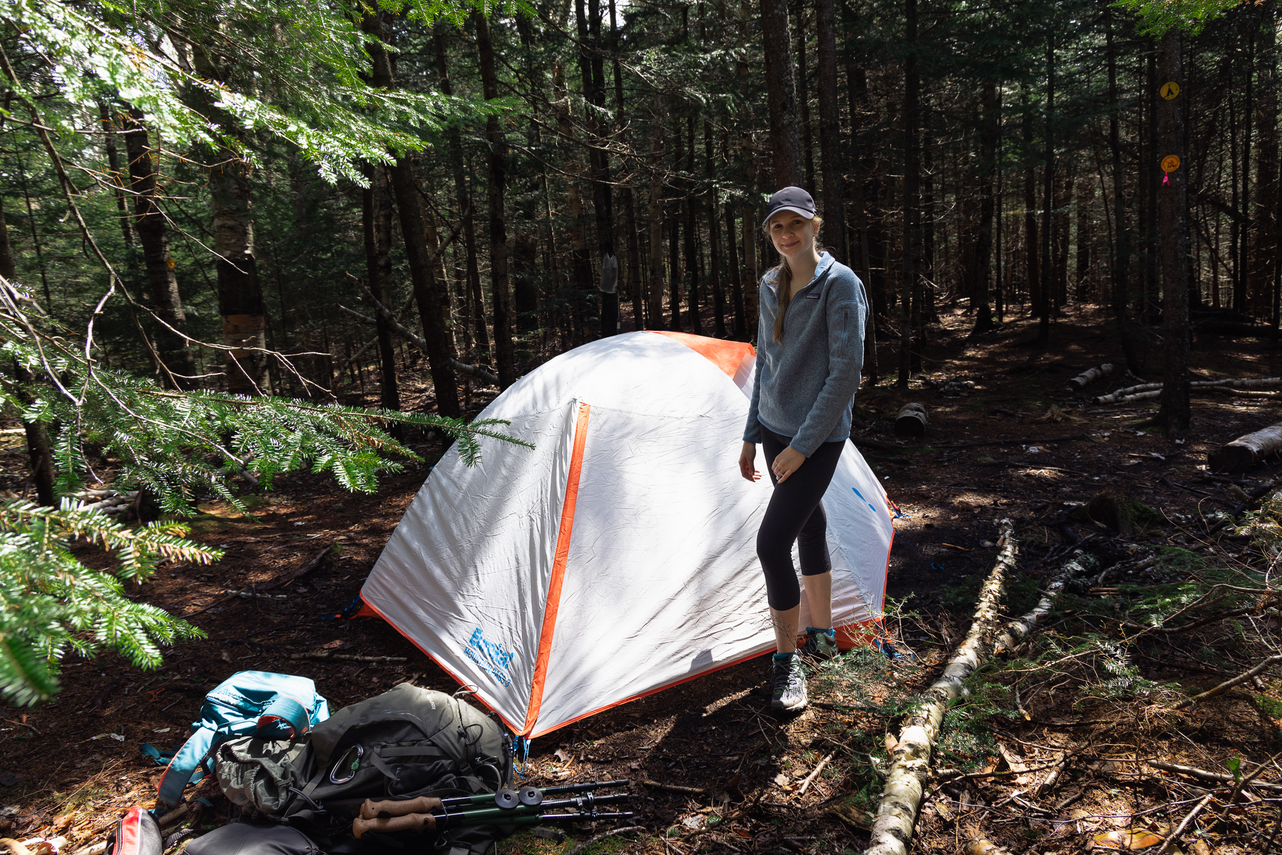 Mitch Bowmile
Mitch Bowmile
If you plan to camp for a few nights and bag High Peaks, Marcy Dam is the perfect spot to call home. From here you can reach a seemingly endless combination of the 46 peaks by taking one trail towards Algonquin, Wright and Iroquois, or another towards Phelps, Tabletop and, of course, Mount Marcy. For long days on the trail or to thru-hike the High Peaks region, you could tag Skylight, Marshall, Colden and Haystack. By completing any combination of hikes, you’ll be treated to stunning views of the highest peaks in the ‘Dacks.
The start of the trail towards Mount Marcy follows Phelps Brook, a beautiful flow of meltwater heading down from Phelps Mountain towards lower ground. The elevation drop causes spectacular displays of falls and shoots as the spring melt roars past the rocky and rooted trail.
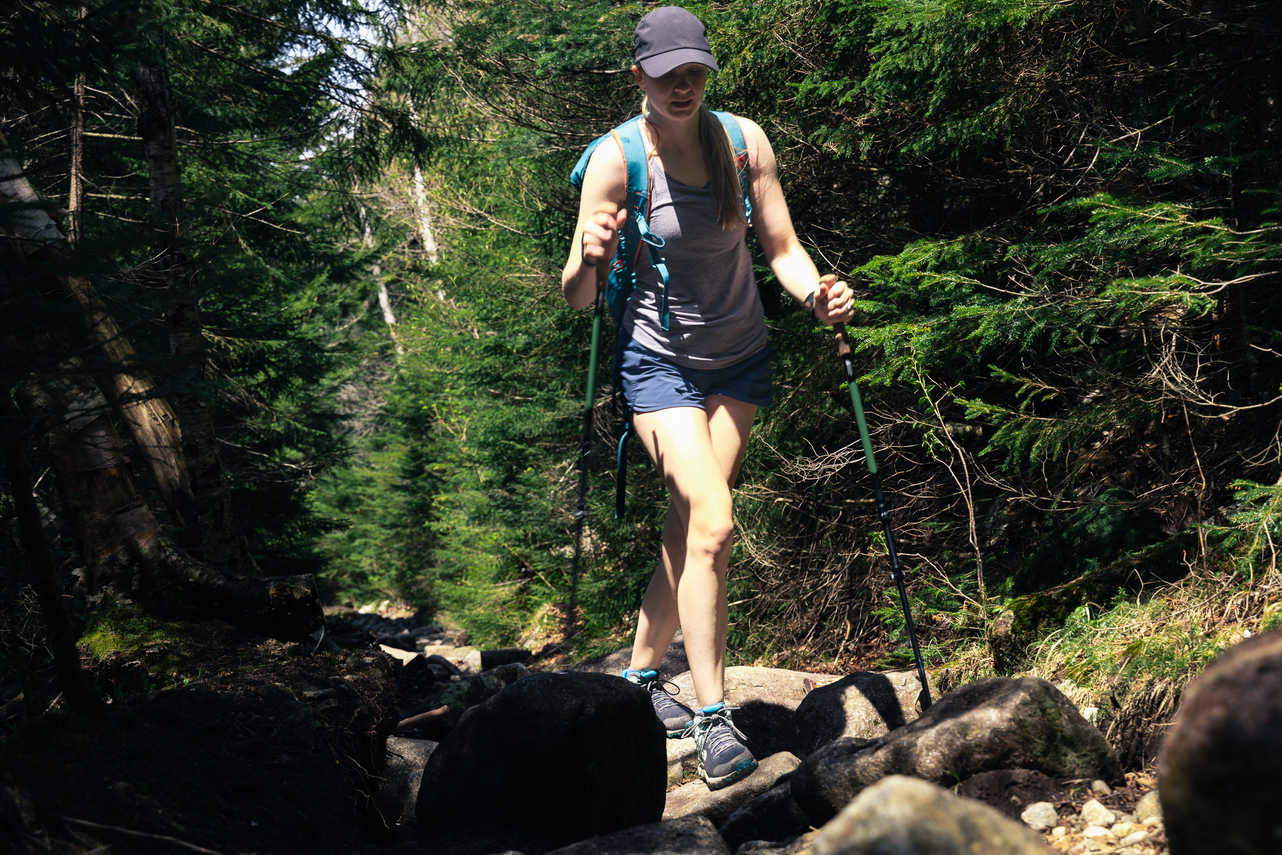 Mitch Bowmile
Mitch Bowmile
In the spring, the Adirondack Mountains come to life. The water is high from the melting snow in the alpine and the vegetation is blooming. Luckily for us, the black flies weren’t out yet, meaning we got to enjoy this pristine mountain landscape without constantly swatting at the low hum of the flies.
The trail crosses the brook twice, once by forcing you to step across a series of rocks that barely break the surface when the water’s high, and once across a well-built bridge. After following the trail for some time, we passed the turnoff to summit Phelps Mountain followed by the one for Tabletop Mountain. Suddenly an opening in the trail announced itself with sunlight and the calming sound of flowing water. As we got closer, another brook was revealed, this time flowing down from the summit of Mount Marcy.
The sun was shining down on the rocky shoreline marking the perfect place to take our first stop for some delicious trail mix, sour keys and corn nuts: the snack of champions and budget hikers. From here, you can head towards the Indian Falls viewpoint. Not realizing how short the detour was, we decided to consider visiting it on the way down from Mount Marcy when we’d have a better gauge on timing and energy levels.
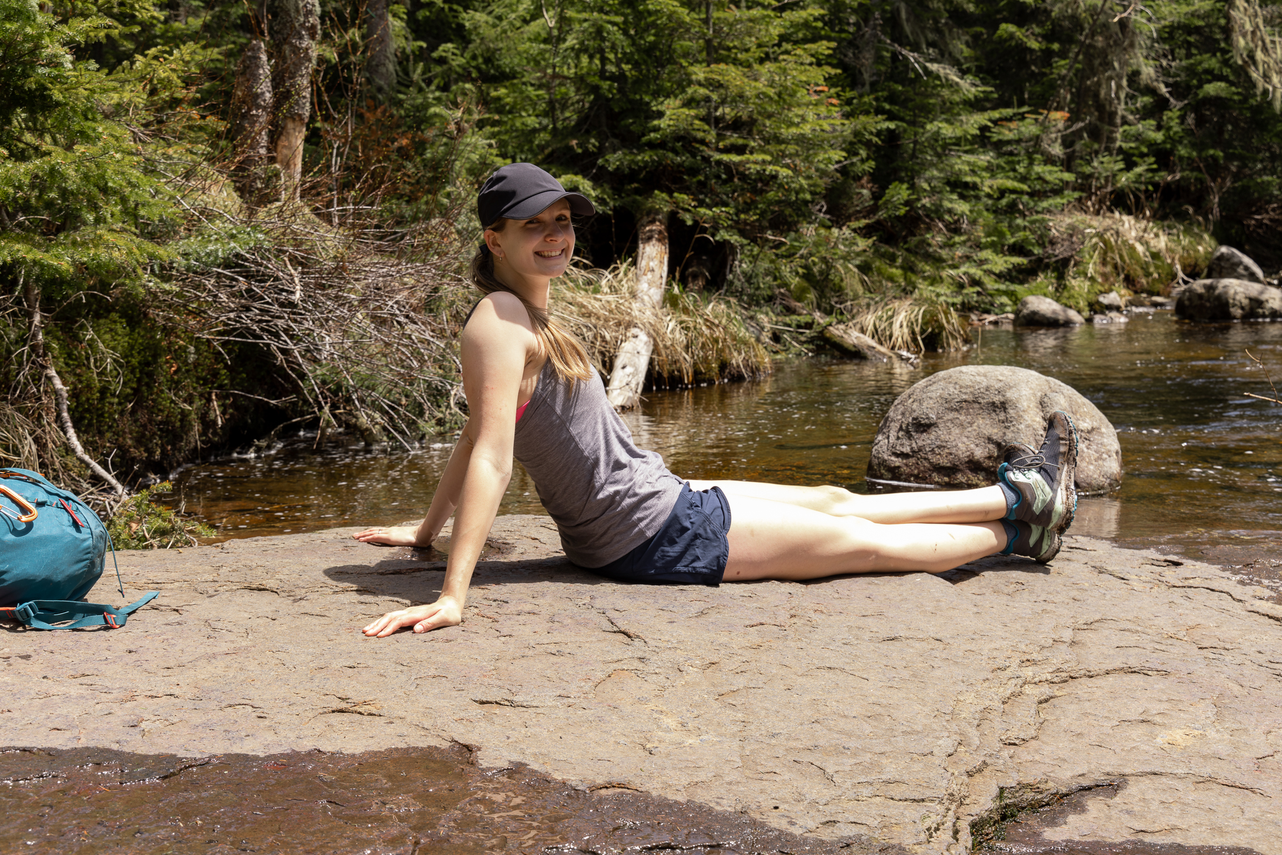 Relaxing by Marcy Brook on the Van Hoevenberg Trail | Mitch Bowmile
Relaxing by Marcy Brook on the Van Hoevenberg Trail | Mitch Bowmile
The word “Adirondack” originates from the name given to the Algonquin tribe by the neighbouring Mohawk for their diet during times of low rations, meaning “bark eater.” The name also fits the treeless tops of the High Peaks emerging from the treeline.
From Indian Falls, the grade of the trail increases significantly into a full quad-burning mountainous ascent. Not only is Mount Marcy the highest point in the Adirondacks, but it has the highest prominence of the 46 peaks, rising 1,498 metres from its base.
As if ushered in to reward us for the countless kilometers we had already hiked, stunning blue-bird views of the surrounding mountains emerged through the trees on the side of the trail. As we continued our ascent, the mixed forest began to transition into a conifer-dominant display of swaying hemlock, spruce and pine that became increasingly shorter in size.
Snow on the trail gave us the indication that we were beginning to reach the final push to the summit. We paused to take trail crampons out of our bags and slipped them on to the bottom of our hiking boots. Just after midday, with plenty of time for the warmth of the sun to find its way onto the trail, the snow was slushy, slippery and a disaster for secure footing. We continued cautiously, watching our steps as the precarious footing on the hard-packed snow threatened to send us on a mid-thigh post-holing detour off trail.
 Mitch Bowmile
Mitch Bowmile
Emerging into exposed sections where the sun has free rein to melt snow all day, we entered large swaths of bog-like terrain where the only way across was through. The shin-deep water teased a path of rotten logs and the odd rock, but it didn’t take long until that ended and succumbing to water-logged boots was the only way forward.
Now joined by the constant squish of water leaving the mesh of our boots with every step, we continued towards the summit.
On our way through another flooded section of trail, we bumped into another couple with soaking feet beginning their descent. After sharing the classic hiker small talk (including favourites such as “you’re almost there!”), one of the two paused for a second before asking if we’re Canadian. When we said that we were, he excitedly shared that they were visiting from Kingston, Ontario.
The first signs of the summit greeted us with exposed rock and stunted trees. At this altitude and level of exposure, large trees can’t grow. Only trees small enough to be engulfed by snow during the winter months can survive the hostile conditions.
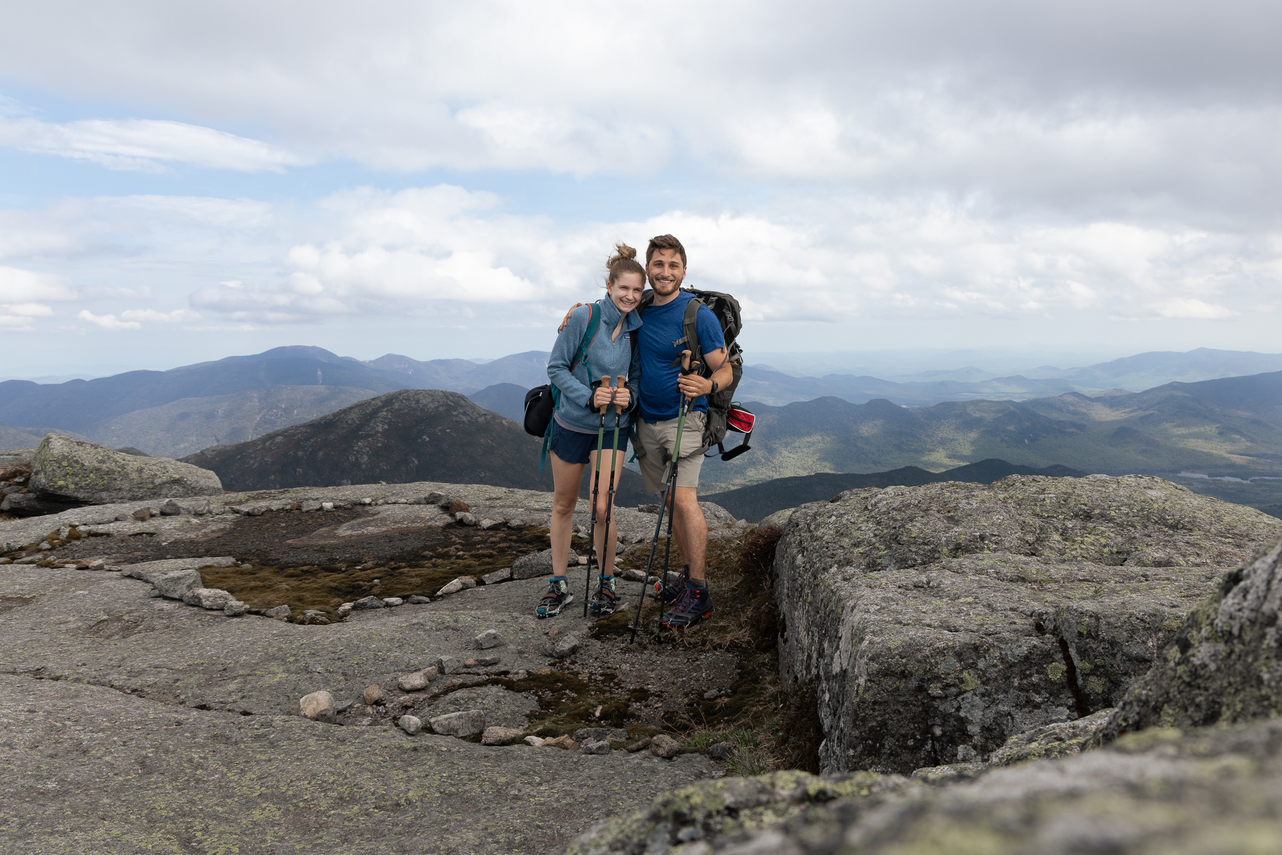 Mitch Bowmile
Mitch Bowmile
The last push to the summit of Mount Marcy is a steep ascent on rock covered in rare mosses and lichens; alpine vegetation so sensitive to disturbance that it’s crucial you stay on the path marked by yellow paint.
Passing sections that could almost be considered a scramble, we took our final steps and walked onto the roof of New York. A rush of energy hit us as we took in the power of the elements led by the howling winds. We celebrated, snapped a few photos and absorbed the panoramic view that comes with standing on the highest point in a mountain range. In every direction, the tops of peaks emerged from the forests below.
Summit moments never last long. They’re exciting, but ultimately the bulk of the enjoyment that comes from hiking is on the way up and the way down. I try not to focus on the summit until I’m standing on it. That way, I don’t miss out on enjoying the hike itself. One step at a time, fully present.
We made our way down towards an alcove in the rock that gave us a break from the wind to enjoy a well-deserved very late lunch of canned chicken (yes, canned chicken is a thing, and yes, it’s delicious) and bread.
The wobbly-legged descent took just as much time as the hike up thanks to the assortment of rocks, roots, snow and mud turning the otherwise straightforward trail into a nature-themed obstacle course. Without talking much, we continued on with no plans of stopping, driven to get to camp early enough for a relaxing evening.
My watch showed that it was close to 6:30pm, later than I would have liked to be on the trail. With less than halfway to go until we could enjoy our delicious freeze-dried pad Thai meals courtesy of Happy Yak, we bumped into a group heading up towards the summit. Dressed in tank tops and running shoes they asked us how long it would take them until they reached the summit. Based on the time of day and the clothing they were wearing, I recommended that they continue for only a few more minutes to a lookout and then return.
I’m not a fan of trail snobs. I love seeing people getting outside and connecting with nature who seem new to whatever outdoor endeavour they’re taking on. The more people respectfully enjoying the outdoors, the better, but you’ve got to be safe in any mountainous terrain.
The Adirondacks offer easily accessible day-hikes, so sometimes people can treat it like a jaunt in the woods. But these are still mountains. Weather can change on a dime, and despite how close you are to your car, if something goes wrong up there, help is a long way away. The Adirondack Mountains deserve the same respect as any other range.
We continued our descent, passing familiar sections of trail until we were back in camp ready to settle in for the night. We grabbed our cooking gear, food and camp chairs, and walked down to Marcy Brook to catch the sunset and cook some dinner. After 20 kilometres of hiking in the mountains, I knew that once I sat down in that camp chair, it would be a good few hours and a whole lot of wine until I was getting up again.
 Mitch Bowmile
Mitch Bowmile
After more boxed wine than I care to admit, we left the peaceful flow of the brook and returned to our campsite full, tired, sore and ready to climb into our sleeping bags and fall asleep to the sounds of the ever-growing howling winds.
More USA-based Outdoor Adventues:
An Ode to Mammoth Lakes: The Best-Kept Secret Mountain Town in California
7 Epic Outdoor Adventures near Eugene, Oregon
The 10 Best Dog-Friendly Hiking Trails in USA National Parks















